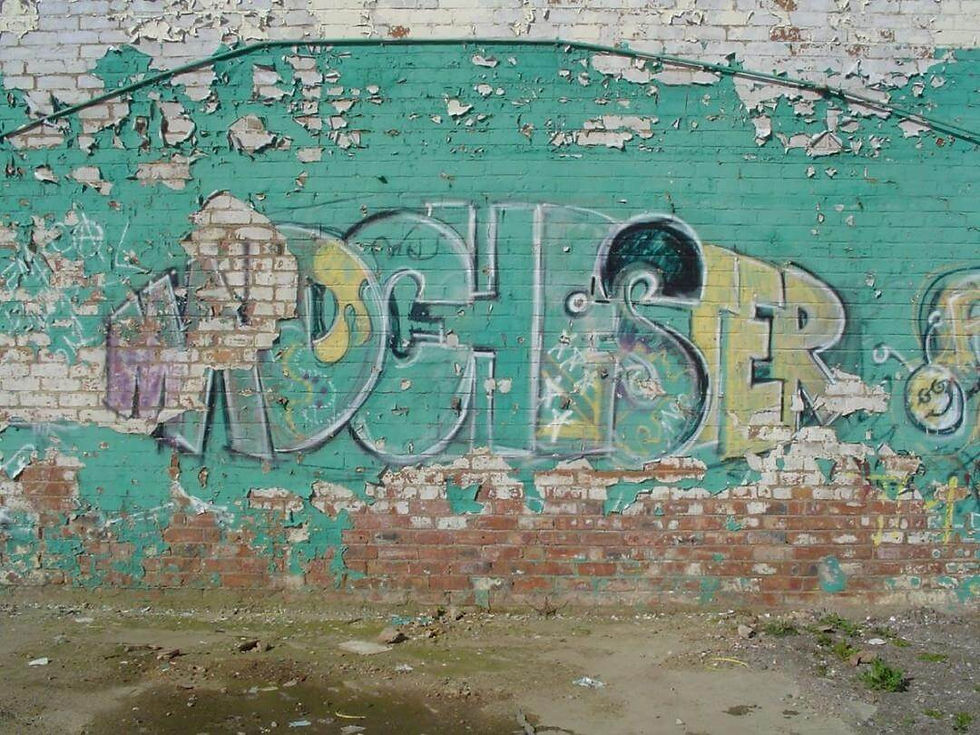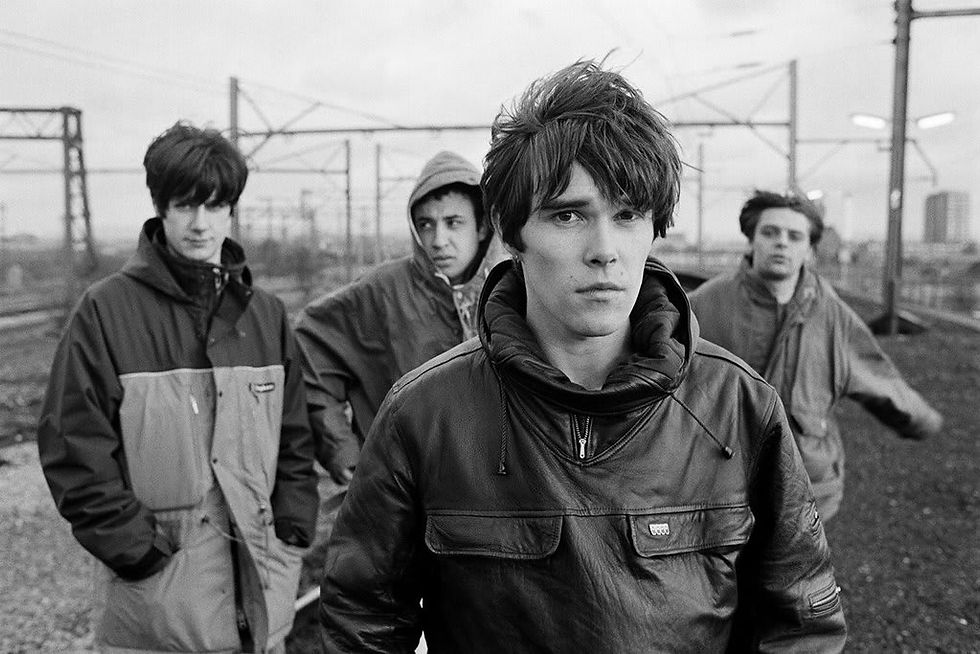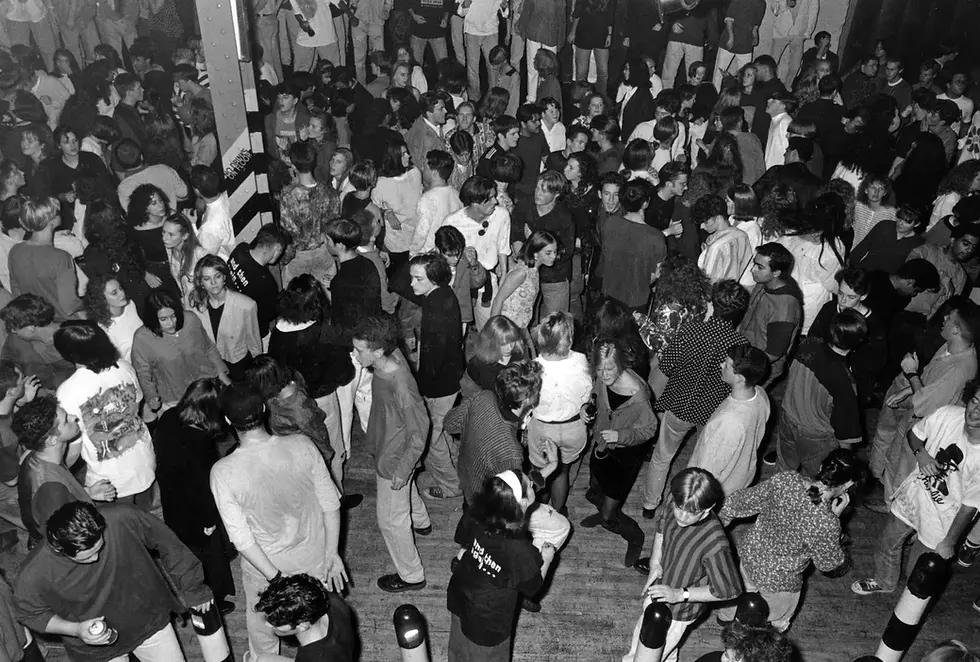Madchester: The Beat That Rocked Britain
- PK White
- Nov 13, 2023
- 7 min read
Updated: Dec 29, 2023

(Madchester Street Artwork outside The Hacienda in Manchester)
Manchester, England, a city synonymous with grey skies and an industrial spirit, found itself awash with color and sound as the Madchester scene burst into life in the mid-80s, marrying guitar-forward indie rock with the groove of dance music and setting the stage for decades worth of musical influence. The growing desire for indie rock timed perfectly with an explosion of Baggy culture and an increasingly party atmosphere in Northern England as Madchester took the city by storm. Britain fell in love with groups like The Stone Roses, Happy Mondays, 808 State, The Charlatans, and Inspiral Carpets as they captured the energy of a generation so well, eventually crossing over into the underground indie scene of the United States. Bands more entrenched in the alternative rock side like The Stone Roses saw massive local success alongside respectable international success, whereas some of the more electronic/acid house groups like 808 State experienced primarily heavy localized success. Nevertheless, Madchester welcomed them both equally, with the more rock-focused groups frequently delving into the acid house and psychedelic side of the genre, doing it to perfection. The question remains, though: what exactly was it about this musical, countercultural revolution that was infectious?
The story of Madchester begins in 1982 at The Hacienda, an industrial warehouse turned nightclub. The venue, which faced serious financial peril essentially from the start, was owned by Factory Records. Fortunately for the club, Factory Records had just signed New Order, giving the club some clout, along with some money. The Hacienda quickly became a hotspot for some of the label's other artists, notably The Happy Mondays and Northside. The venue's industrial atmosphere welcomed rave culture, turning shows into massive, energetic atmospheres that went deep into the night. The Baggy culture of the time embraced loose-fitting, dance-friendly clothes along with a carefree, freedom-filled energy engulfing a working-class generation. Many of these youths ended up frequenting The Hacienda, making it the spot to be for about ten years in Manchester. The energetic youthful clientele brought in a culture of partying and psychedelic drugs to the mix, resulting in drug-fueled, unworldly raves at The Hacienda.
(The Hacienda 1990 - Manchester Evening News Photograph)
(The Hacienda Dancefloor - Manchester Evening News Photograph)
The Hacienda created a hotspot for Madchester as it continually housed bigger and bigger names like Primal Scream, a Scottish band that embraced a funk-inspired Madchester sound. Of all the bands who frequented the club, the premier act of the time was Manchester's own The Stone Roses. The band released their critically acclaimed debut album in 1989, housing some of the most well-known and well-received Madchester songs of the era like the ten-minute long, acid-fueled track Fools Gold or the pivotal indie rock anthem for a generation I Am the Resurrection. The latter of the two songs begins as an infectious, guitar-forward indie rock song before introducing a singalong-style shout chorus and eventually going full Madchester with a four and a half minute dance party to close out the track. The Stone Roses crafted their sound from a bountiful mix of Beatles, Byrds-esque '60s pop, the British '80s indie rock of The Smiths and The Jesus and Mary Chain alongside some reggae and early EDM. The final result was a sound so new, so unique, so pristine, and so infectious.
Sadly for The Stone Roses, their tenure was hampered by continual legal battles, long periods of inactivity, and a bad relationship with the media. By the time of their second release Second Coming in 1994, Madchester was already on its way out, with the city now being a hub for Britpop. To make matters worse, Second Coming was also not all that loved by the fans who had been eagerly waiting five years for a release. The record has since aged even worse, although it has its moments.

(Pictured - The Stone Roses)
The other side of the Madchester coin was 808 State. The brains behind 808 State was Graham Massey, who focused on much of the writing, along with keyboards, programming, and some modest guitar use. Behind Massey was Gerald Simpson, who left 808 State in 1989 to pursue his successful solo career. Simpson did his part to put Madchester on the map with his 1989 single Voodoo Ray, which became a cornerstone of the acid-house, techno side of Madchester. The 1989 808 State single Pacific State became another foundational Madchester track and was again written by Gerald Simpson. The techno/acid-house side of Madchester played a pivotal role in the established rave-like mentality popping up over the city. Although sonically speaking, this side didn't delve too far into the rock side of Madchester, the rock side certainly embraced the acid-house sound and became quintessentially incorporated into the entire scene.
Much of The Hacienda's notoriety came from its well-known resident DJs. Of all the venue's DJs, perhaps the most impactful was Mike Pickering, who also worked A&R for Factory. Mike Pickering also signed James, To Hell, and The Happy Mondays to Factory Records, giving these bands plenty of slots at The Hacienda. Graeme Park was another notable DJ at The Hacienda and around the city. Park was known for his long sets, mixing techno with acid house. He is also credited as one of the pioneers of rave culture. Dave Haslam, another resident DJ at the club, was known for mixing indie, house, and alternative rock, adding to the diverse Madchester sound after DJing at the club over 450 times.
The climax of Madchester was notably the Spike Island Festival held May 27, 1990. The festival featured The Stone Roses and headliners alongside a handful of support DJs like Dave Haslam and Frankie Bones. Although it really was not all that long ago, the festival holds a mythical-like nature around it as there were no full recordings of the performances and there was also a limited media presence. The festival has been compared to Woodstock '69 due to its counterculture presence, youthful crowd, and cultural significance, although the lineup was a fraction of what Woodstock's was. Nevertheless, the festival was a monumental experience for thousands of young people and considered the peak of the Madchester scene.

(Original Spike Island Concert Ticket)
Following Spike Island in 1990, Madchester saw about one more year of dominance in British music before its eventual demise began to take shape. By the early '90s, The Hacienda saw its financial troubles continue to worsen alongside increasing gang violence in the area, resulting in multiple shootings outside of the club between 1991 and its closing in 1991. The Hacienda by this point also had multiple drug overdoses reported within its walls by the mid-90s. The increasing violence and unhinged nature of the nightclub led to increased security measures including searches, police presence, and the installation of metal detectors. Even though these measures were taken with public safety as the primary concern, the vibe of the club had dramatically changed and it simply was not the place to be anymore.
To make matters worse for the Madchester sound, by 1991, the artists now coming out of Manchester were no longer of the Madchester sound and attitude. Britpop giants like The Verve and Oasis were now taking over alternative radio and eventually mainstream radio, pushing the Madchester acts to the side. Across the pond in the US, Nirvana had also just dropped Nevermind alongside Pearl Jam's Ten, changing the interests of the underground music scene in North America. With The Stone Roses putting forth radio silence during this period, along with The Happy Mondays breaking up following their underwhelming 1992 album Yes Please!, air was being let out of the Madchester balloon rapidly. By 1995, British music was completely focused on Britpop, and North America was enthralled with alternative rock and grunge, leaving little to no room for Madchester.
Although its run in music was brief, the influence of Madchester was a massive one. Apart from The Stone Roses' debut being a complete masterpiece, often considered one of the finest British albums of all time, the bands, particularly on the rock side of Madchester, are frequently held in high regard by music enthusiasts and journalists. The Stone Roses and Happy Mondays in particular are frequent flyers on indie and alternative playlists. Regarding the EDM side of Madchester, the scene played a massive role in modern rave culture, leading to the explosion of EDM festivals. EDM festival attire still takes cues from the baggy style, with concertgoers still wearing loose-fitted clothes and enjoying the party drugs of the late '80s. Modern-day DJs match the long-form danceable rhythm of Madchester alongside repetitive and often predictable song styles to encourage dancing and increase energy. Both scenes also had a fascination with the newest, best speakers, alongside other sonic equipment used to create an innovative, loud, exciting party atmosphere.
Madchester played a huge part in the direction most clubs began to go in the '90s switching the emphasis from bands, to DJ's; hip-hop played a significant part in that as well. Of all of the similarities between Madchester and the modern rave culture associated with EDM was the massive inclusivity of the scenes. It didn't matter who you were, where you came from or what you looked like, the feeling of the Madchester raves was an inclusive, communal, party atmosphere, where everyone was looking out for eachother, and ethos echoed today in rave culture. Although Madchester was derived from indie and alternative rock, which is certainly not the case for EDM, what's certain is, modern rave culture certainly derived largely from Madchester.
Madchester was infectious, exhilarating, and often deeply intricate. It was apolitical, focused on inclusivity and having a good time before anything else. The music scene left Manchester with one of it's finest eras of music that impacted so many people for decades to come, even though it was relatively short-lived. By the mid '90s the Madchester bands still around continued to record and release music to limited success, but the eyes of the world were now directed at britpop. Nevertheless, Madchester was an elaborate, colorful illustration of a generation of fun-loving, good hearted people, from a very special city.
Check us out on Instagram @melophobemusic for new articles, releases, reviews, pictures and more!


























